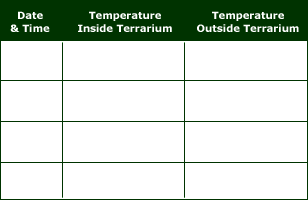
1 clear, tall, airtight container (such as a large empty plastic jar with a screw top or a glass canister with an sealed lid)
potting soil
small plants (such as mosses, ferns, philodendron, pothos, African violets)
pebbles or broken flowerpot chips
filtering charcoal (not barbecue charcoal) Note: You can find this at pet stores.
2 small thermometers (about 4-5 inches long)
paper towel or cloth
water


Wipe clean the inside of your container with paper towel or cloth.


Place a one-inch layer of pebbles in the container.


Next, cover the pebbles with a thin layer of fine charcoal.


Then add about 1 inch of potting soil over the charcoal.


Create a little hole in the soil. Place one or two small plants in the terrarium. You may need to add a little more soil so the roots are covered.


Water the plants until the soil is moist but not soggy. (You may want do this over the sink or a large dish.)


Place a small thermometer on the soil, near the edge of the container so it's easy to read the temperature.


Cover your container with an airtight lid.

Place the terrarium in a window that's well lit, but not too sunny. Place the second thermometer next to the terrarium.


Over the next few days, observe your terrarium closely. If water droplets don't form on the sides, add a little more water. If mold develops, remove the top and leave it off for a few days to let the soil dry out a little. Chances are you won't ever need to water the soil because water from the leaves will form water vapor, then condense into water droplets inside the top.

Observe and record how the plants grow inside your terrarium. Also keep a chart of temperature readings inside and outside the container. Was there a difference?
Why do you think that is? Compare your findings with a friend or classmate. You should find that the more sunlight a terrarium receives, the bigger the temperature difference inside and outside the terrarium.




 Biodiversity
Biodiversity
 Brain
Brain
 Genetics
Genetics
 Marine BiOLogy
Marine BiOLogy
 MicrobiOLogy
MicrobiOLogy
 PaleontOLogy
PaleontOLogy
 ZoOLogy
ZoOLogy
 AnthropOLogy
AnthropOLogy
 ArchaeOLogy
ArchaeOLogy
 Astronomy
Astronomy
 Climate Change
Climate Change
 Earth
Earth
 Physics
Physics
 Water
Water
